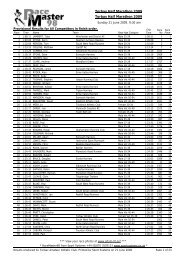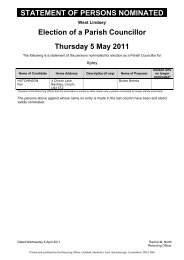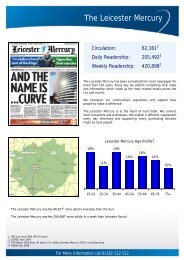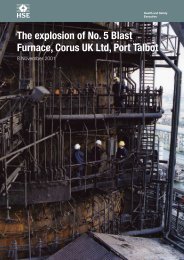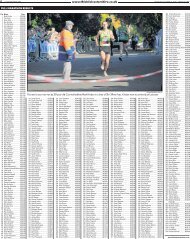A cArbon cApture And storAge network for yorkshire And humber
A cArbon cApture And storAge network for yorkshire And humber
A cArbon cApture And storAge network for yorkshire And humber
You also want an ePaper? Increase the reach of your titles
YUMPU automatically turns print PDFs into web optimized ePapers that Google loves.
A second part of this initial phase, and<br />
<strong>for</strong> each large capacity increase, will be<br />
the aggregation of commitments. For this<br />
we see the Carbon Capture and Storage<br />
Partnership <strong>for</strong> Yorkshire and Humber as the<br />
starting point.<br />
Looking to the local community,<br />
communication and engagement will<br />
have to develop so that the benefits are<br />
understood and people have the facts<br />
available when particular questions and<br />
consultations arise so that timely and<br />
appropriate decisions are made.<br />
Outward communication and awareness<br />
will also be important. Firstly to attract a<br />
cluster of early CCS projects, secondly to<br />
ensure national political support and thirdly,<br />
because of the excellent potential to do so,<br />
to materially contribute to meeting the UK’s<br />
climate change targets.<br />
Stern states that a disproportionately<br />
large share of the burden <strong>for</strong> achieving<br />
the required cuts will have to be borne by<br />
the power-generation sector (Reference 1<br />
pxiii):“Large-scale uptake of a range of clean<br />
power, heat, and transport technologies<br />
is required <strong>for</strong> radical emission cuts in the<br />
medium to long term. The power sector<br />
around the world will have to be at least<br />
60%, and perhaps as much as 75%,<br />
decarbonised by 2050 to stabilise at or<br />
below 550ppm CO2e.” Given the substantial<br />
power sector in the Yorkshire and Humber<br />
region the scale of the transport <strong>network</strong><br />
covered by this study will support<br />
this requirement.<br />
Carbon Capture and Storage Network 41<br />
The range of scenarios <strong>for</strong> the <strong>network</strong><br />
covers transport of, in total, between 150<br />
and 470 million tonnes carbon dioxide by<br />
2030 and by 2050 between 630 million<br />
tonnes (with no further sources added after<br />
2030) to 1700 million tonnes (with high and<br />
continuing CCS after 2030).<br />
The capital cost spend is about £2.0<br />
billion if it was all built today, but spreading<br />
expenditure over time and adjusting <strong>for</strong><br />
inflation, the present cost of a decision to<br />
build a <strong>network</strong> depends on the discount<br />
rate you choose to apply, but <strong>for</strong> a 6.5%<br />
discount the capital costs vary by scenario<br />
from £0.7bn to £1.0bn, and with a 14%<br />
discount rate the present cost of the<br />
decision is to spend £0.3bn to £0.6bn.<br />
The “Central” scenario and 11% discount<br />
gives a £0.7bn present cost.<br />
Operating costs are also modelled and<br />
the combined capital and operating spend<br />
divided by the amount of carbon dioxide<br />
transported is used to calculate the present<br />
value using a range of discount rates<br />
to reflect the time and risk value of the<br />
expenditure. These costs, as explained<br />
previously, are not the revenues required.<br />
The cost per tonne transported is<br />
there<strong>for</strong>e dependent on how long the<br />
system operates and under what financial<br />
assumptions, but <strong>for</strong> a fixed asset<br />
maximising volumes per year means lower<br />
costs per tonne and a longer period are<br />
cheaper per tonne. However cutting the<br />
period of consideration to from about 2015<br />
to 2040, about 25 years of operation, the<br />
unit costs are more representative, though<br />
we are still only in 2008. The different<br />
scenarios, <strong>for</strong> a given discount rate, show<br />
very little difference in unit costs. For<br />
example <strong>for</strong> an 11% discount rate the cost<br />
per tonne varies from £1.5 to £1.7/tonne.<br />
Due to investment timing the “Central”<br />
scenario has the higher rate, and that<br />
cost of £1.70/tonne has been used as the<br />
illustrated result. The conclusion is that the<br />
discount rate is more important than the<br />
scenarios when looking at transport costs<br />
per tonne.<br />
Given a range of discount rates of 6.5%<br />
to 14% the costs per tonne of £1.2/tonne<br />
($2.1, €1.6/tonne) to £3.4/tonne ($6,<br />
€4.7/tonne), with a mid point of 11% of a<br />
round £1.7/tonne ($3.1, €2.4/tonne) CO2<br />
transported as at 2008 <strong>for</strong> the period 2015<br />
to 2040.



